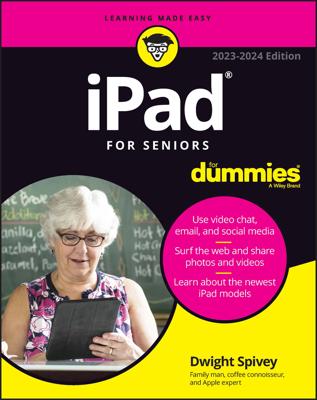The iPad is a combination of a killer audio and video iPod, an e-book reader, a powerful Internet communications device, a superb handheld gaming device, a still and video camera, and a platform for over 850,000 apps at the time this was written — and probably a lot more by the time you read this.
The iPad has many best-of-class features, but perhaps its most notable feature is its lack of a physical keyboard or stylus. Instead, it has a super-high-resolution touchscreen — 132 pixels per inch (ppi) for second-generation iPad and 264 ppi for the third and fourth generation — that you operate using a pointing device you’re already intimately familiar with: your finger.
And what a display it is. All four generations have beautiful screens, and the third-generation, fourth-generation, iPad Air, and iPad mini with Retina display sport Apple’s exclusive high-definition Retina display, which is easily the most beautiful screen ever seen on a tablet.
The iPad also has a plethora of built-in sensors. It has an accelerometer to detect when you rotate the device from portrait to landscape mode — and instantly adjust what’s on the display accordingly.
The screen rotates — that is, unless the Screen Orientation Lock is engaged. A light sensor adjusts the display’s brightness in response to the current ambient lighting conditions.
In addition to the aforementioned sensors, iPads have a three-axis gyro sensor that works in conjunction with the accelerometer and built-in compass.
Last, but definitely not least, the latest iPads (all but iPad 2), running at least iOS 6, come with Siri, a voice-controlled personal assistant happy to do almost anything you ask.
The iPad as an iPod
As the late Steve Jobs said: The iPad is magical — and without a doubt the best iPod Apple has ever produced. You can enjoy all your existing iPod content — music, audiobooks, audio and video podcasts, iTunes U courses, music videos, television shows, and movies — on the iPad’s gorgeous high-resolution color display, which is bigger, brighter, and richer than any iPod or iPhone display that came before it.
Here’s the bottom line: If you can get the content — be it video, audio, or whatever — into iTunes on your Mac or PC, you can synchronize it and watch or listen to it on your iPad. And, of course, you can always buy or rent content on your iPad with the iTunes Store and iBooks apps.
Some video content may need to be converted to an iPad-compatible format (with proper resolution, frame rate, bit rate, and file format) to play on your iPad. If you try to sync an incompatible video file, iTunes alerts you that an issue exists.
If you get an error message about an incompatible video file, select the file in iTunes and choose File→Create New Version. When the conversion is finished, sync again.
The free HandBrake application often provides better results than iTunes when converting movie files to an iPad-friendly format. It has a preset for the iPad, so it’s simple to use, and it can often convert movie files and formats that iTunes chokes on.
The iPad as an Internet communications device
Not only is the iPad a stellar iPod, but it’s also a full-featured Internet communications device with a rich HTML e-mail client that’s compatible with most POP and IMAP mail services, with support for Microsoft Exchange ActiveSync. Also onboard is a world-class web browser (Safari) that, unlike what’s on many mobile devices, makes web surfing fun and easy on the eyes.
Another cool Internet feature is Maps, a killer mapping application that’s much improved in iOS 7. By using GPS (3G or 4G models) or triangulation (Wi-Fi-only models), the iPad can determine your location, let you view maps and satellite imagery, and obtain driving directions and traffic information regardless of where you happen to be. You can also find businesses, such as gas stations, pizza restaurants, hospitals, and Apple Stores, with just a few taps.
The iPad as an e-book reader
Download the free iBooks app and/or any of the excellent (and free) third-party e-book readers such as the Kindle and Nook apps, and you’ll discover a whole new way of finding and reading books. The iBooks Store and Newsstand app are chock-full of good reading at prices that are lower than what you’d pay for a printed copy.
Better still, when you read an e-book, you’re helping the environment and saving trees. Furthermore, some (if not many) titles include audio, video, or graphical content not available in the printed editions. Plus, a great number of really good books are absolutely free. And best of all, you can carry your entire library in one hand. If you’ve never read a book on your iPad, give it a try.
The iPad as a multimedia powerhouse
The spectacular screen found on second-generation iPads is superb for personal video viewing, and the Retina display on the third- generation and later iPads make it even more extraordinary. Add an adapter cable and it turns into a superb device for watching video on an HDTV (or even a non-HD TV), with support for output resolutions up to 1080p.
You won’t even need an adapter cable if you have an Apple TV ($99), a marvelous little device that lets you stream audio and video to your HDTV wirelessly.
And all iPads include a pair of cameras and the FaceTime video-chatting app, taking the iPad’s multimedia acumen to new heights.
The iPad as a platform for third-party apps
The App Store offers more than 1,000,000 apps for the iPhone, iPad, and iPod touch at the time of this writing, in categories that include games, business, education, entertainment, healthcare and fitness, music, photography, productivity, travel, sports, and many more. The cool thing is that most of them, even ones designed for the iPhone or iPod touch, also run flawlessly on the iPad.
Of those 1,000,000+ apps, more than 400,000 are designed specifically for the iPad’s larger screen, with more arriving daily.

